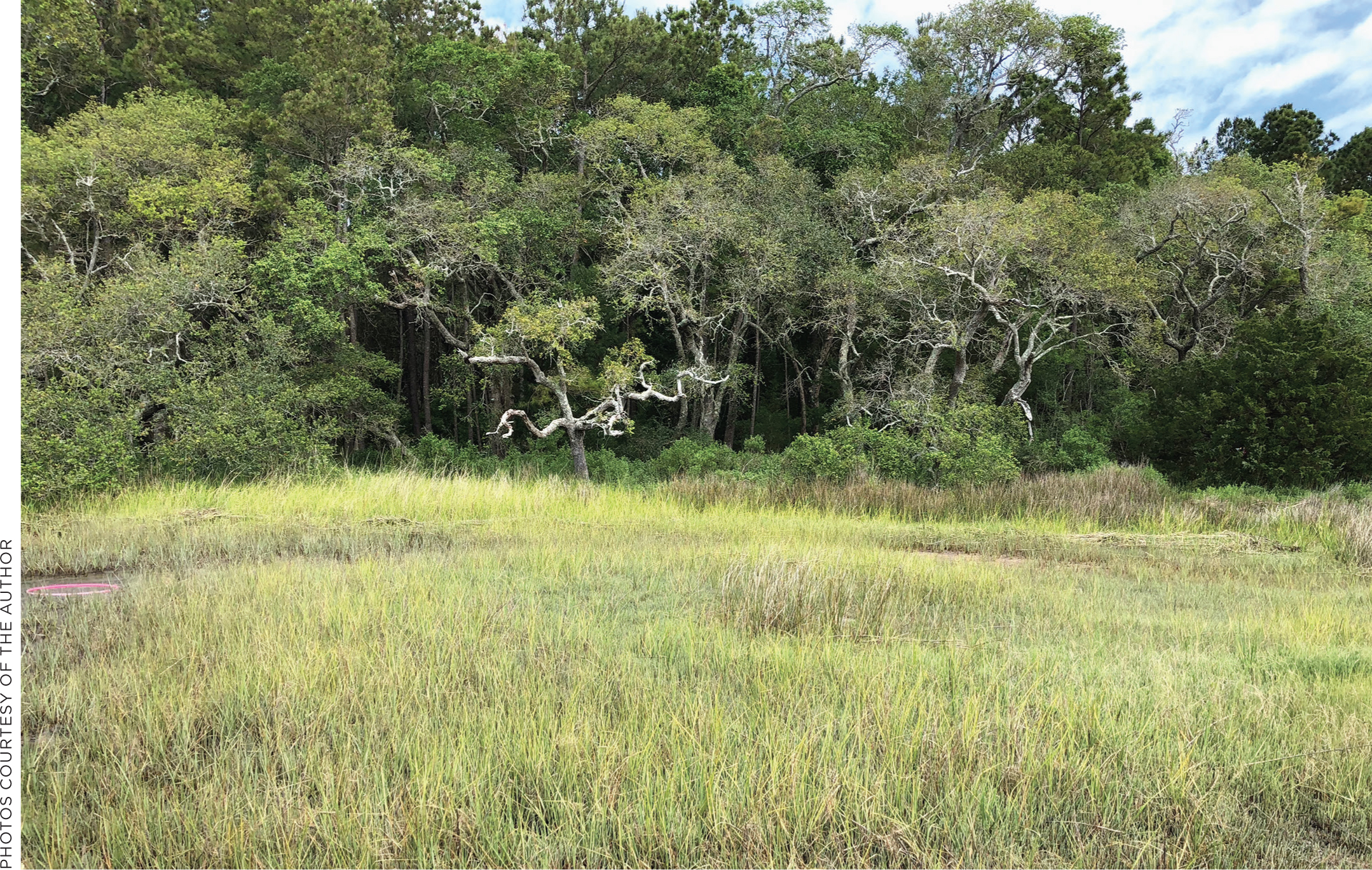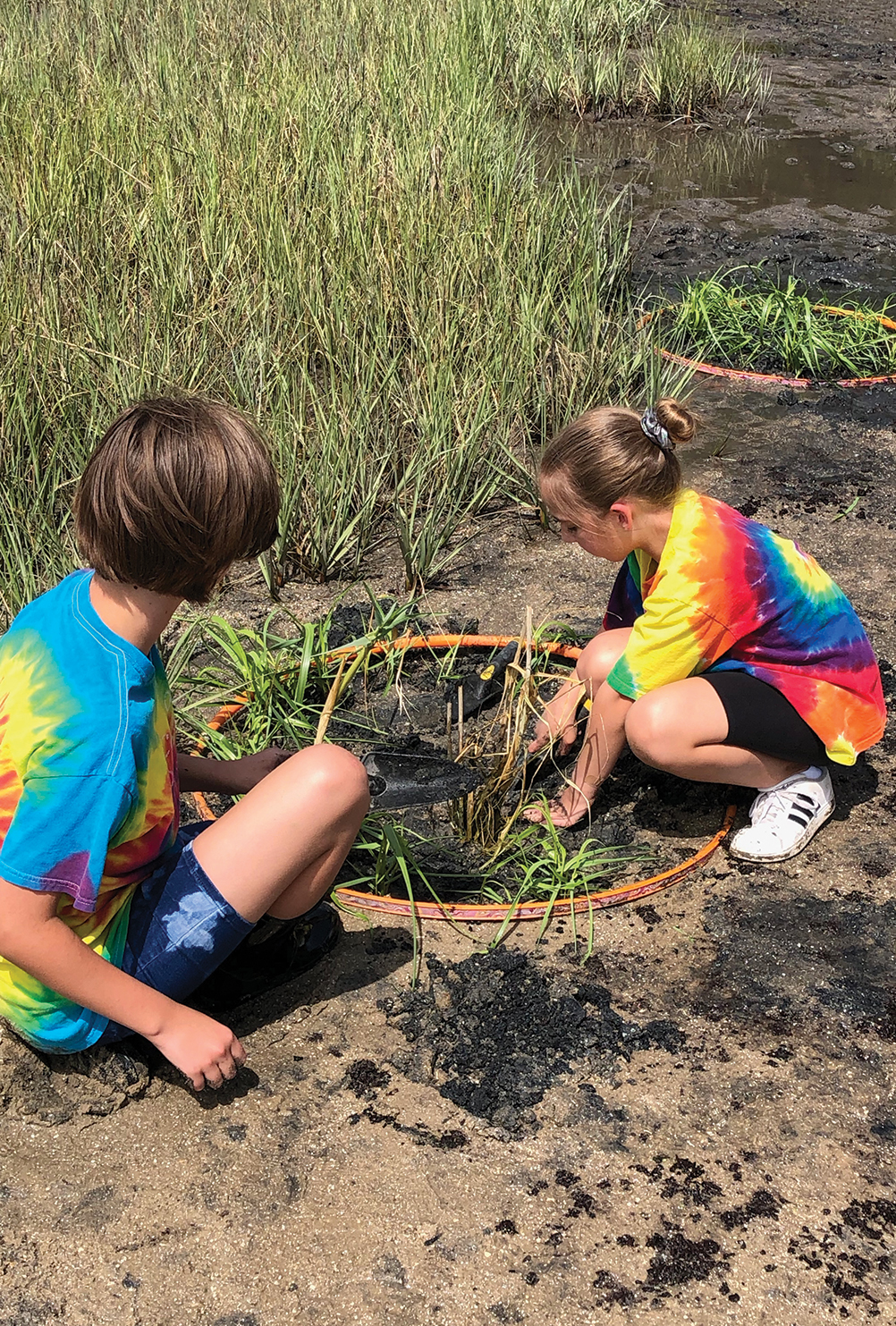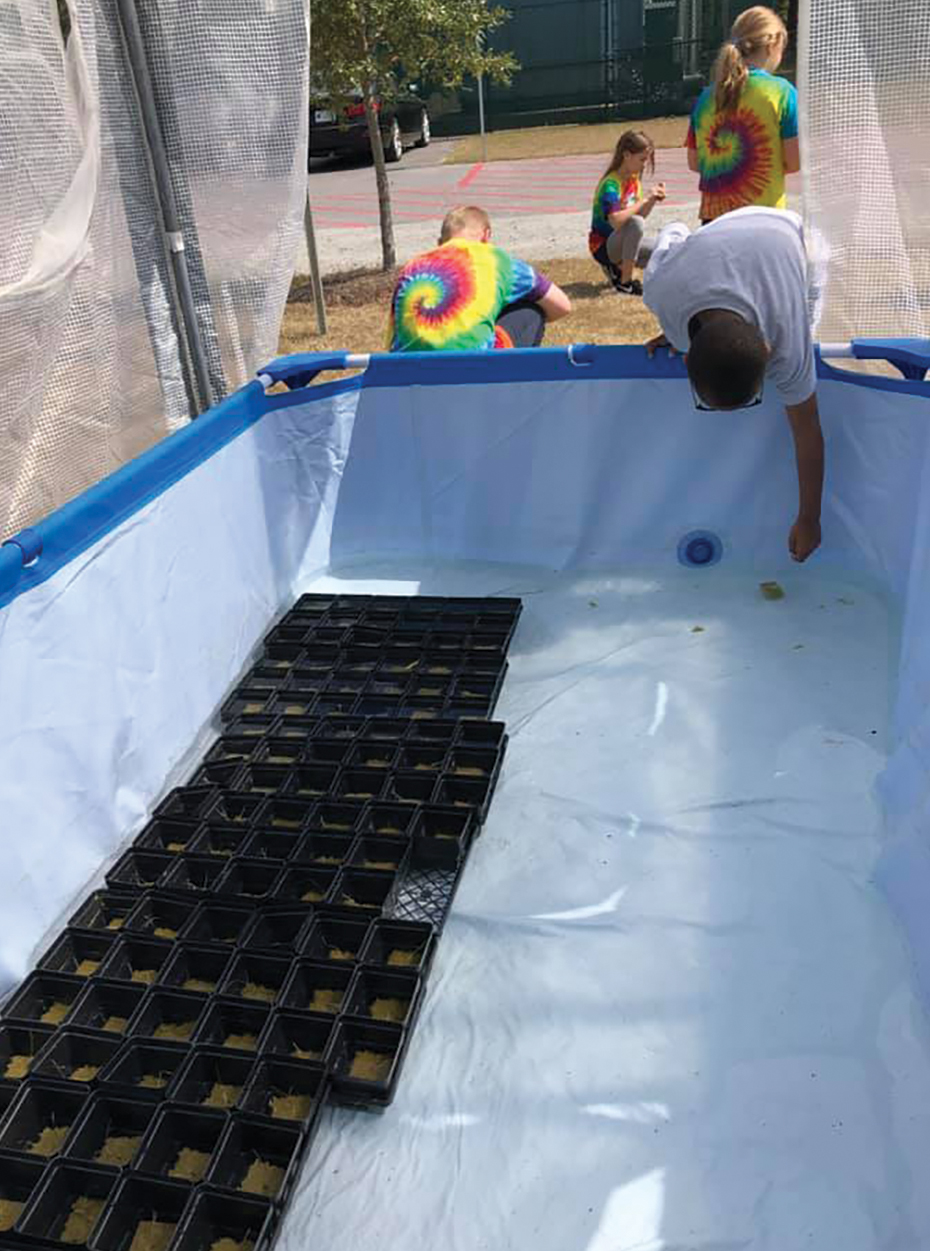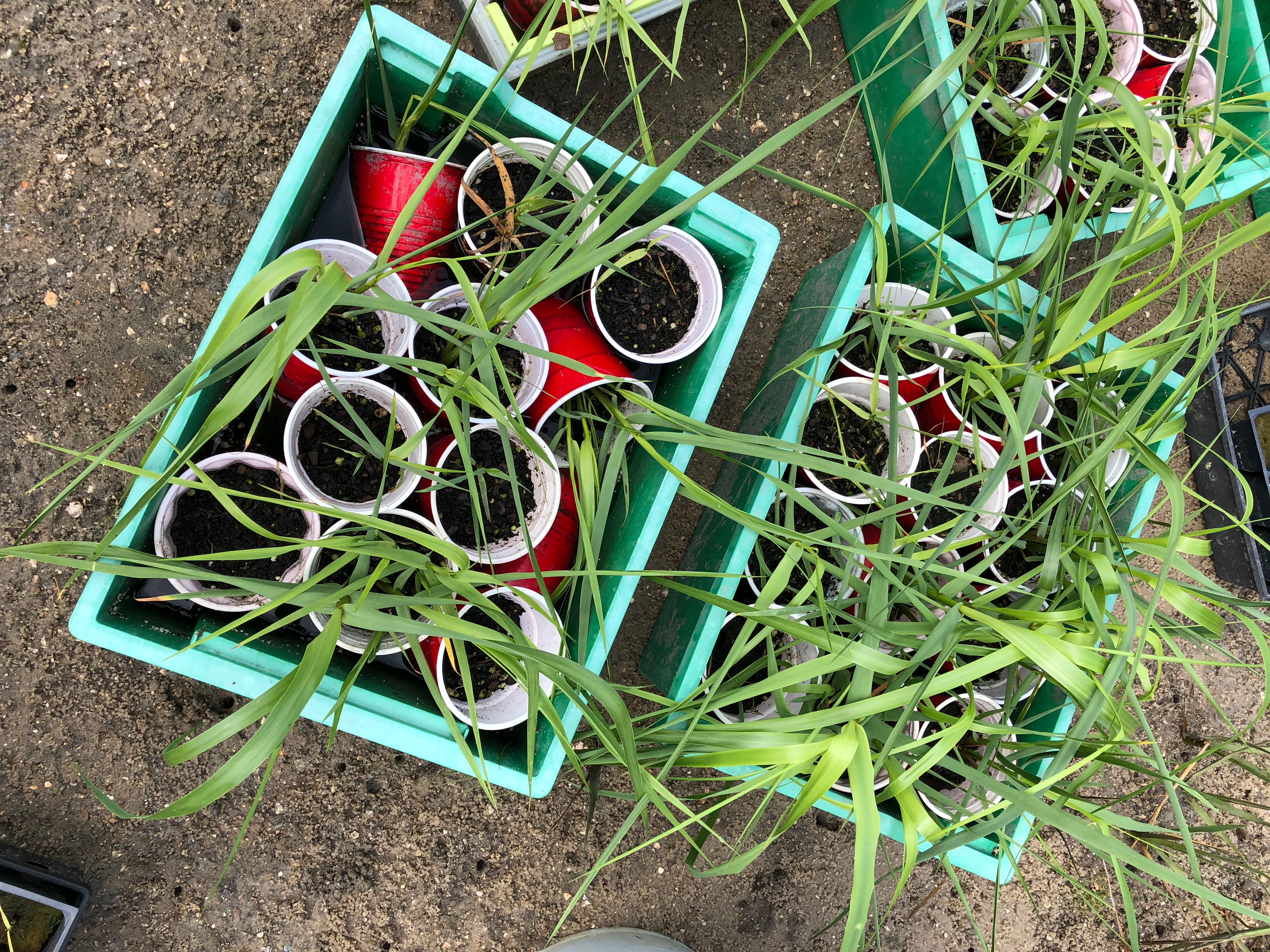Feature
Sowing Spartina
Fifth graders learn how planting this key species can lead to a cleaner marsh
Growing up in a small coastal town, our students spend a great deal of time outdoors and at the beach. Given the many learning opportunities that such an environment can provide, engaging our students in a sustained, environmental service project seemed like a natural complement to lessons focusing on the interaction of organisms within a habitat. This experience provided opportunities for students to examine how we can improve the water quality of our marshes. In this unit, fifth-grade students planted and raised Spartina grass in a portable greenhouse at school, then worked with a organization to plant the seagrass in our local marsh to provide refuge for animals and help support the environment.
What Is Spartina?
Our community is located right on the coast of the Atlantic Ocean. We have one large barrier island between us and the ocean, creating a marsh habitat between the mainland and our island’s beaches. Because the marsh serves as such an important part of our community’s lives for the economy and recreation, Sarah, a local fifth-grade teacher, knew that students were already familiar with the marsh, its location, and appearance. To capture their attention, samples of dead Spartina shoots were shared with the students to see if they could identify what the grass was and how it is used within the ecosystem. Spartina is a type of cordgrass native to salt marshes of the Atlantic coast. It grows in dense colonies and blooms in the summer and fall (University of Florida Center for Aquatic and Invasive Plants 2018). Spartina serves as a base for our sand dunes, buffering our marsh from the ocean waves on the other side of the beach; as the dead cordgrass piles up, it is covered with sand, creating the dune. The cordgrass grows quickly, and when alive, aids in preventing erosion and serves as a food source for organisms within the marsh. The students were able to identify the grass as growing at the beach but were unfamiliar with its many roles within the marsh habitat.
Once the term Spartina was introduced, students were asked what the grass might do for the marsh. The students discussed how it “might be a home for an animal” or “serve as food for animals.” Their ideas were affirmed, and Sarah shared how the grass also served as part of the structure for building dunes and preventing erosion. Students were surprised that the grass could serve so many roles, whether dead or alive, reinforcing the idea of interdependence between organisms. Students were asked why this might matter to us as humans, who do not live in the marsh. They were able to share that the marsh provides food for us when we go fishing and that we like to play on the beach that is protected from erosion.
Raising Spartina
Once students had a general idea of the role that Spartina plays in the ecosystem, Susan explained that the students would be helping to raise Spartina as part of a marsh restoration project through a program called “From Seeds to Shoreline” offered through our state’s South Carolina Sea Grant and the South Carolina Department of Natural Resources. Through the program, classrooms are provided the seeds to plant and grow Spartina, which they then plant in the marsh upon project completion. While participation in the project is of no cost to the school or classroom, the school needed to have a small greenhouse (<10 × 10 ft) and planting supplies available, including soil and planters. Teachers looking for these resources might choose to create project requests on a website like DonorsChoose.org or look to their local gardening clubs or plant nurseries for support.
For the project, each student was provided a large plastic cup (reused for years of the project) and soil in which to plant their Spartina seeds. Students planted their seeds in potting soil, and each cup was put in the greenhouse. After a discussion on possible growing methods (hydroponics, potting soil, or sand), students chose to try two different methods for growing their Spartina: seed cups could be immersed completely in water, using hydroponics, or watered as needed. Once students chose their methods, cups were arranged in the greenhouse to meet student needs. The cups requiring watering were left on shelves, while those being immersed were in small square buckets filled with water.
Each day, two students were responsible for checking the temperature, water levels, and windows and door of the greenhouse to make sure that water and heat levels were appropriate. While this system worked well for the three months (February–April) that the Spartina grew, there were several learning opportunities for students along the way! At one point, one of the square buckets got a hole in it, leaving the formerly immersed plants dried out. The students then had to determine how to handle the situation, eventually opting to just refill the water and wait to see if it would be successful, which it was. Another time, students left the windows open to the greenhouse. That night significant storms came through, flooding all of the cups and forcing students to start over again. Fortunately, Spartina is quick growing and fairly resilient, so these moments did not derail the project.
The Value of the Marsh
While the Spartina was growing, students were provided the opportunity to explore the marsh and role of the marsh in providing a habitat for organisms. Working with Annie, the grant program representative, students participated in the game Wetland Metaphors from Project Wild, where items are pulled from a bag or pillowcase and the students explain how the item represented the marsh (see Internet Resources). For example, when a student pulled a sponge from the bag, Annie explained how the marsh “keeps things clean, like a sponge.” Susan and Annie explained how the marsh serves as a filtration system for water. Another student pulled pacifiers out of the bag, making the connection that the marsh served as a nursery for baby aquatic life. Use of the marsh metaphors activity again provided students an opportunity to see how matter and energy cycle through an ecosystem and how each organism within that environment plays a part.
Next, the class discussed the role of the Spartina in the marsh as a support for the organisms that lived there. When examining systems, it is important to note that there is often interdependence between the parts of a system, and that one piece of the system aids in supporting other parts (NRC 2012); Spartina has long roots, allowing it to aid in erosion prevention, an important characteristic in an area frequently impacted by hurricanes and storm surge. Spartina seeds are frequently consumed by both native and migrating birds (SCDNR 2015). The living grass provides a place for the animals in the marsh to safely raise their young, providing a connection between the Spartina and the metaphors activity. From that connection, students were asked to consider why more Spartina might be important to them, and why humans needed to aid in planting more Spartina grass. One student shared that more fish and organisms growing meant more potential food for people, and that more organisms also meant more people might want to come and see them, benefitting the community (ecotourism). Due to numerous severe weather events over the past three years, the marsh grass had thinned out quite a bit due to flooding and heavy winds. Students realized that a clean and full marsh meant more opportunities to both provide food and enjoy the outdoors, thus providing benefits not just for the animals living there, but the individuals visiting the area, too.

Students viewed a marsh area where previous students had planted Spartina.
Planting Time!
Once the Spartina was of sufficient length, it was time to load up the plants and students to head to the marsh! The students, teachers, and parent volunteers were met by Annie, who explained to the students how to plant their Spartina grass. First, students were shown areas where previous classes had planted Spartina grass, so that they could see the impact of the project on the local habitat, reinforcing the idea of observing changes over time. Students were in groups of three to four students, grouped based on their classroom table mates. Annie laid hula hoops down in areas where Spartina grass was needed, and each group was responsible for planting their Spartina seeds in the hula hoop. Each group was also responsible for counting the number of stalks planted. Each group was given spades to dig holes and instructed that each hole needed to be a few inches deeper and wider than the Spartina plant. In total, the classes planted a total of 485 Spartina stalks!

Hula hoops indicated where to plant.
Safety tip: Be sure to inform students of poisonous/thorny plants to avoid, to observe but not interfere with wildlife, and to also be sure to wear secure shoes that will stay on in the pluff mud (the thick marsh mud typical of this environment)! Although our students were not in the water for this activity, also reminding students of appropriate water safety measures may also be needed.
Informing the Community
After planting their Spartina seeds, the students then were asked to create signs to protect the Spartina grass and local beaches. Students were provided 12” × 12” pieces of lumber primed with white paint to create their signs. The students were required to include information about why protecting the area was important and to make the sign visually appealing for those that would be walking on the beach. The students included a variety of facts on their signs, including “Leash your canine companions” and “Please clean up after your pets.” The students’ signs were then going to be posted in the area to bring attention to their work and to protect the environment.
Additionally, students were asked to diagram the flow of matter amongst the organisms within the environment. Students included representations for a minimum of three organisms (Spartina, fish, crabs, and so on.) and arrows demonstrating how energy flows from one organism to another. Such visuals allow the students to see how each organism is connected with the Spartina grass and to identify the roles that each organism plays in the habitat. These ideas reinforce the crosscutting concept of Systems and Systems Models: Students are able to describe the system by its parts and how they interact.
Long-Term Effects
In all, students were excited to participate in this project, especially after viewing how much Spartina the previous participants had planted in the marsh. As one student noted, “We are able to help out, and that feels good.” Providing students opportunities to be engaged with the community and to learn more about how they both affect and can protect the natural environment can help motivate them to become stewards of our local flora and fauna and enables opportunities for students to make connections to how humans can protect our resources and environments. Participation in a long-term project such as this provides students the opportunity to both examine stability and change in the natural environment, as well as create and develop models to represent their ideas and explanations.
Thoughts for Consideration
For students with special needs or accessibility challenges, planning is also important when implementing field projects. For our project, boardwalks would enable opportunities to keep students in wheelchairs mobile and allow them to access the marsh. For one student, who was in a cast, being able to help disperse Spartina plants, count the stalks as they were distributed to groups, and sit and rest while painting her sign were important in keeping her involved. It is recommended that teachers visit the sites where activities will take place prior to the field trip to determine what issues might arise and what challenges can be prevented.
While our project worked well for engaging students in learning about the local environment, we recognize that not all students live near the marsh. Those interested in helping in similar community projects are encouraged to contact their local 4H groups, nature centers, and state parks to see how their students might be able to contribute. For example, students may be able to assist in growing and planting local pollinator species to aid honeybees, or they could raise milkweed to support monarch butterflies. If growing plants is not an option, participating in projects such as the Great Backyard Bird Count or the Great Sunflower Project (see Internet Resources) also provide meaningful ways for students to become aware of and advocate for local environmental health.

Students deposit seedlings in a greenhouse.
ACKNOWLEDGMENT
Thank you to Sarah Wilson for the opportunity to follow this experience and for her feedback on the manuscript.
Catherine Scott (cscott1@coastal.edu) is an associate professor of elementary education at Coastal Carolina University in Conway, South Carolina.
Biology Earth & Space Science Life Science Teaching Strategies Elementary



